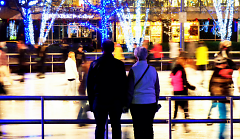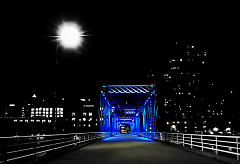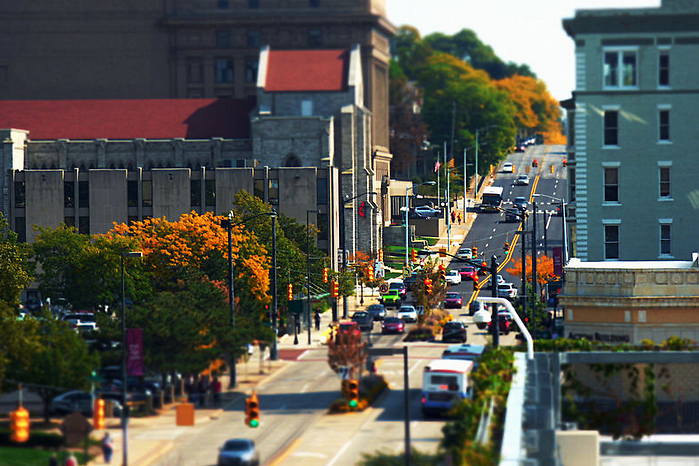
Ice skating at Rosa Parks Circle /Ann-Marie Jurek

Blue Bridge /Ann-Marie Jurek

View from Downtown looking up the hill /Ann-Marie Jurek

Ice skating at Rosa Parks Circle /Ann-Marie Jurek

Blue Bridge /Ann-Marie Jurek
Written by Kristopher Larson, AICP
Over the past year, I’ve spent a good deal of time speaking to audiences across the country about citizen engagement within the context of city-building. My postulation concludes on the assertion that for too long, the ends - planning functions, processes and policy making - dictated the means by which we have sought the engagement of our citizens. In most cases, these means were reactionary mechanisms created to serve the context of yesterday. You know these mechanisms well – they include all of the “town hall,” “charrettes” and “public hearing” opportunities we still clutch on to as sacrosanct symbols to get to know our neighbors.
Alas, times change and technology changes even faster. Today, it takes a heckuv-a-lot more than an amplified microphone or a set of markers and a flip chart to prove that we are listening. As communications platforms evolve and automate, so do our needs as purveyors of citizen involvement to adapt to contemporary expectations. This means we’ve got to be more continually accessible than episodic, and our relationships with citizens become far less ivory tower and more social network. After all, real citizen engagement is governed by the same aspirations that govern our personal relationships: sincerity, follow-through, commitment, trust, compromise, growth and communication. Great planners recognize that their communities are their families. And like families – we as planners create the conditions to be trusted, embraced, beloved, estranged or divorced from our communities.
The GR Forward Planning process made a commitment to provide a comprehensive set of inclusive engagement opportunities in order to demonstrate the planning team’s commitment to doing this right for our community. To date, the GR Forward Planning process has meaningfully involved more than 1,000 citizens in determining a direction for how our Downtown and riverfront areas can progress for the betterment of the Grand Rapids community. Armed with a detailed understanding of where we are – backed by reams of expertly collected and collated data and insight – this battalion of the willing and has provided the GR Forward team with enough raw material and reflection to produce a draft vision statement, which I’m proud to share with you now.
For those of you that may be unfamiliar with the higher-elevation side of city planning, a vision statement describes a potential future. It is aspirational and provides guidance in taking steps to achieve the outcome you want. Associated with a vision statement are goals, which are more specific statements designed to help achieve the vision. They should provide a framework for organizing strategies. Strategies (coming in February and March of 2015) are the specific actions that will fulfill your goals and the vision. The GR Forward strategies will include descriptions of what should be done, where, when and how (funding and partners).
DRAFT GR Forward Vision Statement and Goals:
Downtown Grand Rapids is the region’s downtown and the civic heart of West Michigan. It will reflect an attainable and inclusive urbanism welcoming to downtown residents, nearby neighbors, and visitors. Together, the Downtown and the River will provide an experience that can’t be found in Western Michigan and strengthen the City’s brand as progressive, healthy, and vibrant. To accomplish this, we need to:
Goal 1: Create a true neighborhood.
Housing is the driver to build more value downtown and more demand for the services that people want.
Goal 2: Restore the river.
It’s the game-changer for Grand Rapids that can help to attract talent and elevate the City as a unique destination, an armature for development and an amenity for the region. Grand Rapids has the opportunity to offer a unique experience around outdoor adventures not usually found in urban centers such as rowing, kayaking, white water, fishing, camping, sledding, skating, cross country skiing, swimming, urban camping and so on.
Goal 3: Strengthen connections between places and across barriers.
Downtown Grand Rapids lacks a sense of unity, creating a fragmented experience and sense of inactivity. The West Side offers a range of affordable housing options but is historically disconnected. Improved downtown connections are also needed to leverage the growth of Monroe North and the opportunities in the southwest portion of Downtown Grand Rapids. Create strong linkages and development strategies that mimic the connection to the east side neighborhoods.
Goal 4: Ensure continued vitality of the local economy.
Grand Rapids was built upon availability of space for makers and doers. In addition to strategies to retain existing businesses, we need inexpensive, flexible space for new and growing companies near downtown.
Goal 5: Re-orient your view.
To improve access to the Grand River, it’s time to focus on the cross streets. These critical east-west streets will be redesigned to improve access across Grand Rapids’ neighborhoods and help bring the river into the City.
Goal 6: Reinvest in public space.
What are we getting out of our parks and public spaces and how can we rethink them to better serve the community, while further activating Downtown Grand Rapids year-round? Through both programming and design, public investment can make a big impact.
Now, of course, it’s time for our community members to tell us if we got it right. The vision sets the course for the details of the plan, so it’s imperative that we hear from you to learn if this is the future we should work to build together. Please feel free to log onto www.grforward.org to learn about all of the upcoming opportunities to include your voice in this important effort.
The Rapidian, a program of the 501(c)3 nonprofit Community Media Center, relies on the community’s support to help cover the cost of training reporters and publishing content.
We need your help.
If each of our readers and content creators who values this community platform help support its creation and maintenance, The Rapidian can continue to educate and facilitate a conversation around issues for years to come.
Please support The Rapidian and make a contribution today.